Once upon a time, queen of colour Debbie Tomkies worked as an accountant. In her own words; “weird, huh?” But she now spends her days writing books, spinning and dyeing fibres, and teaching others her expert skills. With a colossal career change and two books under her belt, Debbie is the perfect person to give industry (and dyeing!) advice.
When and how did you begin knitting?
I learned to knit when I was about 7. My Gran was an awesome knitter, but she lived in Scotland and we only saw her twice a year so I had to make the most of her visits and learn fast! She was also deaf so knitting was a special language we could share.
What would you like to knit that you haven’t made so far?
I always wanted a Kaffe Fassett jacket but could never afford the yarn. I still find his designs and use of colour a huge inspiration. Some of the designs are perhaps a little 80s now, but many are simply timeless classics.
How many projects do you have on the go at any one time?
Lots! I have car projects, holiday projects, small ones, big ones, collections, workshop samples, the list goes on. Probably about 20 at the moment in various stages of completion.
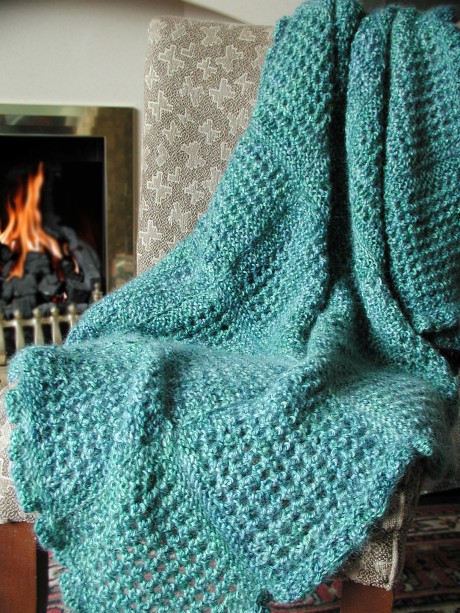
If you could describe your stash in one word, what would it be and why?
Eclectic. It reflects my taste in yarns both past and present and I don’t rule out any yarn as having potential for a future design. You won’t be surprised to hear that colour and texture feature strongly!
What’s the oldest yarn in your stash?
Oh dear. I still have some of the yarn from a sweater my Mum half-completed before she married my Dad, so that’ll be about 50+ years old. I also have some of the yarn from my first sweater – a chocolate brown acrylic double knit – that will be about 35 years old. Crikey, that’s scary!
Is there a yarn you’re desperate to use but can’t decide what for?
I used Cascade 220 for all the step-by-steps in my latest book/video combo, Complete Knitting Skills, and I loved it – the stitch definition is so nice and it’s a lovely, plump DK/light aran weight. When I have finished a couple of ongoing projects I’ll definitely be doing some swatching with it.
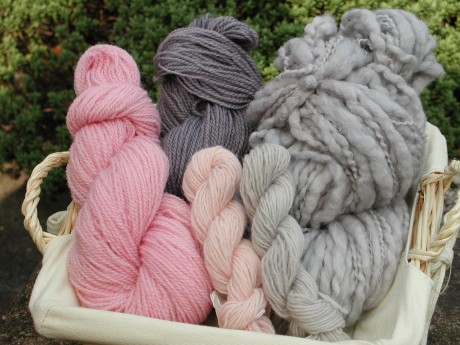
Cochineal Logwood yarns
What inspired you to write Hand Dyed Yarn Craft Projects?
I’d been dyeing for a number of years and I struggled to find many good dye instruction books in the UK. When I was taken ill I had a long time off work and I decided that if I hadn’t found a suitable book, maybe others would like one too. GMC agreed and so the book was published. It did give the nurses a laugh, though, as I was sitting in my hospital bed surrounded by draft pages until the wee small hours. I was having surgery the following morning and the final proofs had to have been checked by then! It was certainly a good distraction.
How did you choose the patterns for your book Hand Dyed Yarn Craft Projects?
I wanted to produce designs that would showcase the reader’s hand-dyed yarns and illustrate the amazing effects that can be achieved by pairing a simple pattern with an amazingly coloured yarn.
How do you choose which colours you are going to use when dyeing yarn?
I take inspiration from many sources. My yarn and fibre clubs have included colourways from space nebulae, flowers, favourite paintings, landscapes, collages of collected images, album covers, rusty piers and even food! I also use Pinterest and trend forecasting websites to keep up to date with what’s hot on the runway.
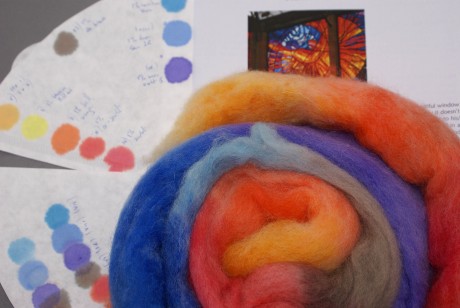
What tips would you give to a beginner wanting to hand dye yarn?
Be bold and go for it! It isn’t difficult or expensive to get started and you don’t need to be artistic to get great results. Start with a simple kit so you’ve got good instructions. When it comes to colours I often suggest a favourite outfit from your wardrobe. Working within a colour-family (eg: purples through blues) or a seasonal theme (autumn golds and red-browns) almost always produces lovely results. Pairing up with a friend and having a dyeing afternoon is also really fun!
How do you think the knitting and crafting industry has changed over recent years?
The internet has revolutionised the craft industry by connecting people. It’s amazing to be able to find and share your passion for crafts with like-minded people; access patterns; self-publish your own designs; learn from video tutorials; share your work and get people together to form “real” as well as online groups. It’s also given yarn spinners and manufacturers access to a wider customer base, encouraging them to produce new, exotic and innovative yarns.
What is it you enjoy most about teaching others?
I’ve learned so much over the years from some amazing teachers and I love passing that knowledge on to others. There are few things more satisfying than watching a student’s expression when a new technique clicks or they find an easier way to do something.
Have you always wanted your own business?
Yes! I loved my job in accountancy (I know, weird, huh?) but being your own boss, responsible for your successes (and non-successes!) is so satisfying. Although it’s scary at times knowing you stand or fall by your own decisions. I absolutely couldn’t do it without the amazing support I get from family and friends - and, of course, customers - but I wouldn’t swap it for the world.
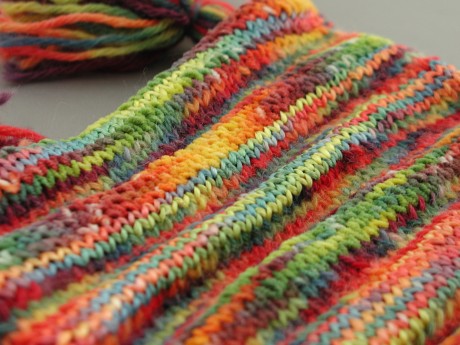
What is your next big project?
I really enjoyed producing the video tutorials for my latest book, Complete Knitting Skills, and I have had lots of great feedback about them, so I’d like to do more video-based teaching. It would be great to be able to connect with students who can’t access my classes but are keen to learn new skills.
Do you have any tips for those who dream about having a career in the knitting industry?
Research and perseverance are probably as important as talent. Raw talent will get you a long way but you need to be pro-active and find out about your potential audience/customers. Think about yourself and your style, too. What do you do that makes you different from others? What’s unique about you and your designs and products? Keep these in focus as it will help you to develop your own personal niche and help to make you distinctive. Take the time to really get to grips with social media but decide where you feel most comfortable rather than doing everything. Sites such as Folksy, Etsy and Ravelry are great places to test the water with your designs, ideas and projects without significant financial investment - but don’t be shy about approaching magazines and publishers.
Do you have anything happening on the horizon you’d like readers to hear about?
Yes, in a slightly odd way! I’m doing a fascinating research project with Armley Mills Industrial Museum in Leeds and I’d love to hear from anyone with involvement in, or contacts in, the dye industry. I’m particularly interested in the transition from small-scale dyeing to large-scale post-Industrial Revolution dyeing and the production and development of synthetic dyes. If anyone has any archive material, family histories, oral histories, books, documents or information they’d be happy to share, do get in touch! We’re really hoping to put the UK’s amazing dyeing history on the map.
For more information on Debbie and her work, go to www.dtcrafts.co.uk


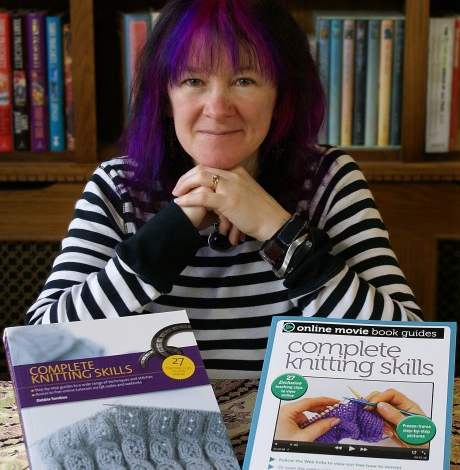

_333_180_c1.png)

_Craftihive_Let_s_Knit_Website_Blog_-_7.9.25_HEADER_IMAGE-01__333_180_64_c1.jpg)

_333_180_64_c1.jpg)
 Baby
Baby
 Toys
Toys
 Garments
Garments
 Crochet
Crochet
 Homewares
Homewares
 Dolls
Dolls



Share